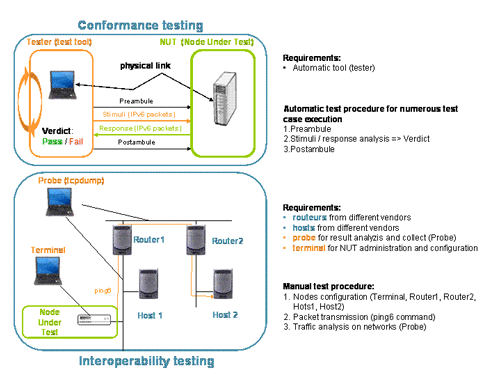
This issue in pdf Subscription Archive: Next issue: October 2005 |
| ||||
Point6: The IPv6 Skill Centre - Moving to the Next-Generation Internet Protocolby César Viho and Annie Floch IPv6 was initially conceived to anticipate the shortage of IP addresses, and to respond to the deficiencies in IPv4 that appeared in the 1990s. These requirements concern both emerging communication technologies (cell phones, PDAs, Internet-connected vehicles, xDSL etc) and billions of new users (in Japan, China, India etc), and they become more significant daily. It is therefore vital that IPv6 be introduced into infrastructures and new projects. Since January 1995, IPv6 has been specified and standardized with the aim of meeting global needs generated by the huge growth of the Internet. In addition to the increased (virtually unlimited) address space, IPv6 offers numerous major design improvements over IPv4. These can remedy the ‘old’ protocol limits, as well as opening the door to innovative Internet-based products and services. Among the most significant of these enhancements are auto-configuration (‘plug and play’) and reconfiguration mechanisms, mobility services, end-to-end security - with IPSec encryption and authentication features - and enhanced support for multicast and QoS. Today, with these technical advantages, IPv6 is widely available from industry and supported by recent network equipments (routers, switches, desktops, servers and operating systems). It has also been successfully applied worldwide by educational establishments, government institutions, telecom companies and research organizations. However, European companies are still behind schedule in the acceptance and deployment of this technology. The common attitude appears to be: “IPv4 is well known and functional. Why should I change? What are the benefits and the associated costs and risks?” Researchers from the IRISA/INRIA and ENST Bretagne/GET laboratories have been involved in the IPv6 project from the very beginning. They co-developed the very first IPv6 stack ten years ago, and have been involved in the IPv6 interoperability testing and the international certification program (IPv6 Ready Logo) since 1999. This expertise develops daily through research activities, IETF standardization efforts, educational duties, technical publications and conferences, prototype implementation and international interoperability test events. The team has been further reinforced by the creation of the Point6 skill centre in Rennes (France). This unique know-how is now available for IT and business managers and engineers who need to understand and control all the IPv6 related issues, prior to organizing any associated work. The ambition of the Point6 experts is to understand and analyse the industry needs, provide efficient solutions, and assist the R&D teams in their adoption of the IPv6 protocol, from the initial requirements to the implementation details. From our experience, the main difficulty is the initial step of IPv6 knowledge acquisition. Once this is achieved, the technical issues are generally well known and decision are quite easy to take. Usually, products have to be both IPv4 and IPv6 compliant, and this can be managed with a minimum of effort.
Another representative case is the network infrastructure migration from IPv4 to IPv6. Most organizations have difficulty making accurate decisions at the right moment, even though they know that IPv6 is now reliable and commonly used in products and from Internet Service Providers. Point6 experts can analyse existing infrastructure and are capable of developing customized migration plans. The main steps typically include IPv6 connectivity, address plan definition, equipment upgrade, routing configuration, network services reconfiguration (firewalls etc), service updates (mail, Web etc), end user equipment and metrics definition. This can be done gradually, retaining the same level of service as with IPv4. Companies that have developed their IPv6 products or want to validate any IPv6 network configuration can use the Point6 platform for both conformance and interoperability testing facilities. Conformance tests verify that an implementation has been developed in strict accordance with its specifications (RFCs). Multi-vendor environments make it necessary to validate equipment compatibility by applying interoperability scenarios. Testing is time-consuming, and requires skill, specialized resources (hosts, routers, probes etc) and rational impartiality. The Point6 test service is based on a platform supplied with up-to-date tests and managed by IPv6 experts. The team has the relevant skills for helping companies to obtain the 'IPv6 Ready Logo', which requires 100% correct results for both conformance and interoperability tests. More tests for IPv6 are available in the laboratory for additional IPv6 routing protocols (RIPng, OSPFv3, BGP4+), mobility (Nemo) and transition mechanisms (NAT/PT, 6to4). Other test suites are also under development. Link: Please contact: | ||||


